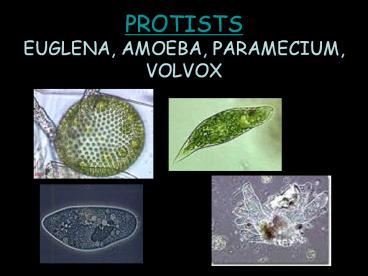PROTISTS EUGLENA, AMOEBA, PARAMECIUM, VOLVOX - PowerPoint PPT Presentation
Title:
PROTISTS EUGLENA, AMOEBA, PARAMECIUM, VOLVOX
Description:
PROTISTS EUGLENA, AMOEBA, PARAMECIUM, VOLVOX What is a Protist? Kingdom Protista Very diverse single-celled organisms. Eukaryotic Less complex with many different ... – PowerPoint PPT presentation
Number of Views:791
Avg rating:3.0/5.0
Title: PROTISTS EUGLENA, AMOEBA, PARAMECIUM, VOLVOX
1
PROTISTSEUGLENA, AMOEBA, PARAMECIUM, VOLVOX
2
What is a Protist?
- Kingdom Protista
- Very diverse single-celled organisms.
- Eukaryotic
- Less complex with many different characteristics.
3
EUGLENA
- Single-celled Protists that live in fresh water.
- Captures and releases energy- producers (make
their own food) and heterotrophs (gets food by
eating other things) - Some contain chlorophyll
4
More Info on Euglenas
- Feedback- Eyespot helps them sense light.
- Waste- Contractile Vacuole holds excess water and
removes it from the cell. - Movement- Flagella
- video
5
More Info on Euglenas
- Reproduction- Asexual (binary fission)
- Specialized Needs- shape does changes easily so
it can move around - http//bio.rutgers.edu/euglena/
6
AMOEBA
- Found in freshwater and salt water around a lot
of dead and decaying material. - Captures and releases energy- parasites, they get
energy by invading other organsisms
7
More Info on Amoebas
- Feedback- pseudopodia (false feet)
- Waste- Contractile Vacuole holds excessive waste
- Movement- pseudopodia (false feet)
- amoeba video
8
More Info on Amoebas
- Reproduction- Asexual (binary fission)
- Specialized Needs- n/a
9
PARAMECIUM
- Found in freshwater. This is a single celled
organism but is more complex that other
organisms. - Captures and releases energy- Cilia sweep food
into food passageway. - VIDEO
10
Paramecium Continued
- Feedback- n/a
- Waste- Anal Pore (food waste is removed) and
Contractile Vacuole (water waste) - Movement- Cilia (tiny hairs that move back and
forth.)
11
Paramecium Continued
- Reproduction- Sexual (two Parents)
- Specialized Needs- Specialized Function Two
nucleuses (Macronucleus and Micronucleus)
12
VOLVOX
- Found in ponds ditches and puddles.
- Composed of a colony of tiny flagellate cells.
(more than 50,000 cells) - Often times called algae.
13
Volvox continued
- Captures and releases energy- photosynthesis and
flagella help bring in nutrients. - Feedback- eyespots to help sense light.
- Waste- n/a
14
Volvox continued
- Movement- Many flagella help move it.
- Reproduction- asexual and sexual, daughters
colonies created. - Specialized needs- n/a
15
Volvox Videos
- video 1
- video 2
- video 3































